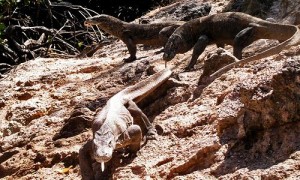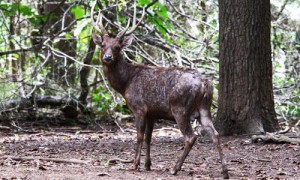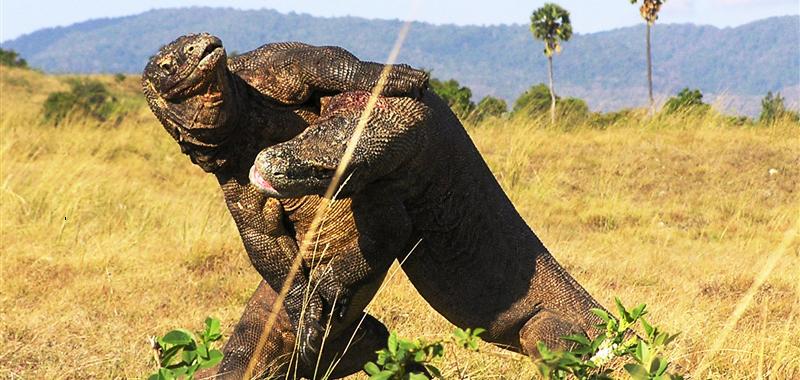The population of wild animals especially Komodo Dragon that is the giant lizard in Komodo National Park.
The park is best known for the Komodo monitor Varanus komodoensis (R), the world’s largest living lizard. The population, which is estimated at around 5,700 individuals, is distributed across the islands of Komodo (2,900), Rinca (900), Gili Motong (fewer than 100) and in certain coastal regions of western and northern Flores. The species is probably extinct on Padar, where it was last seen in 1975. Favored habitat is tropical deciduous forest, and, to a lesser extent, open savanna. Herpetofauna of the cloud forest includes Sphenomorphus schlegeli, S. striolatus and the frog Oreophryne jeffersoniana, while savannah areas harbour such species as Emoia similis, Viperia russelli and the frog Kaloula baleata. Tropical deciduous forest supports such reptiles as Sphenomorphus florensis, Trimeresurus albolabris, Dendrelaphis pictus and Lycodon aulicus. Common cobra Naja naja occurs in areas of disturbed agricultural land.
The mammalian fauna is characteristic of the Wallacean zoogeographic zone, with seven terrestrial species recorded including the endemic rat Rattus rintjanus. Other mammals include primates such as crab-eating macaque Macaca fascicularis. Introduced species, such as rusa deer Cervus timorensis and wild boar Sus scrofa, as well as feral domestic animals including horses and water buffalo, form important prey species for the Komodo monitor. Some 72 species of birds have been recorded, including yellow-crested cockatoo Cacatua sulphurea (V), noisy friar bird Philemon buceroides and common scrubhen Megapodius freycinet.

Komodo Dragons

Timor Deer
Upwelling of nutrient-rich water from deeper areas of the archipelago is responsible for the rich reef ecosystem of which only isolated patches remain due to anthropogenic disturbance. Dominant coral species on most reefs are Acropora spp., particularly table top coral Acropora symmetrica, as well as Millepora spp. and Porites spp. Fungia spp. are present on reef slopes. In areas of strong currents, the reef substrate consists of an avalanche of coral fragments, with only encrusting or low branching species, such as Seriatopora caliendrum and Stylophora pistillata, being able to withstand the rapid water flow. More protected reef slopes, for example in Slawi Bay, are dominated by species of the genus Heteropsammia and Heterocyathus. Reefs off the north-east of Komodo have a high species diversity including branching Acropora sp., Hydnophora sp., Seriatopora sp. and Caulastrea sp., as well as massive Porites sp., plate-like Echinophyllia sp., Merulina sp., Pachyseris sp. and numerous Fungiidae. The reefs off Gili Lawa Laut are variable, ranging from the sheltered southern bay with its large stands of Pachyseris sp., Echinopora sp., Mycedium sp., Echinophyllia sp. and Montipora sp., interspersed with thickets of Acropora spp., to the more exposed northern reefs which have a spur and groove structure dominated by Porites sp., Seriatopora sp. and Acropora sp.
Notable marine mammals include blue whale Balaenoptera musculus (E) and sperm whale Physeter catodon, which are occasionally observed, as well as 10 species of dolphin and dugong Dugong dugon (V). Marine reptiles include five species of turtle.






